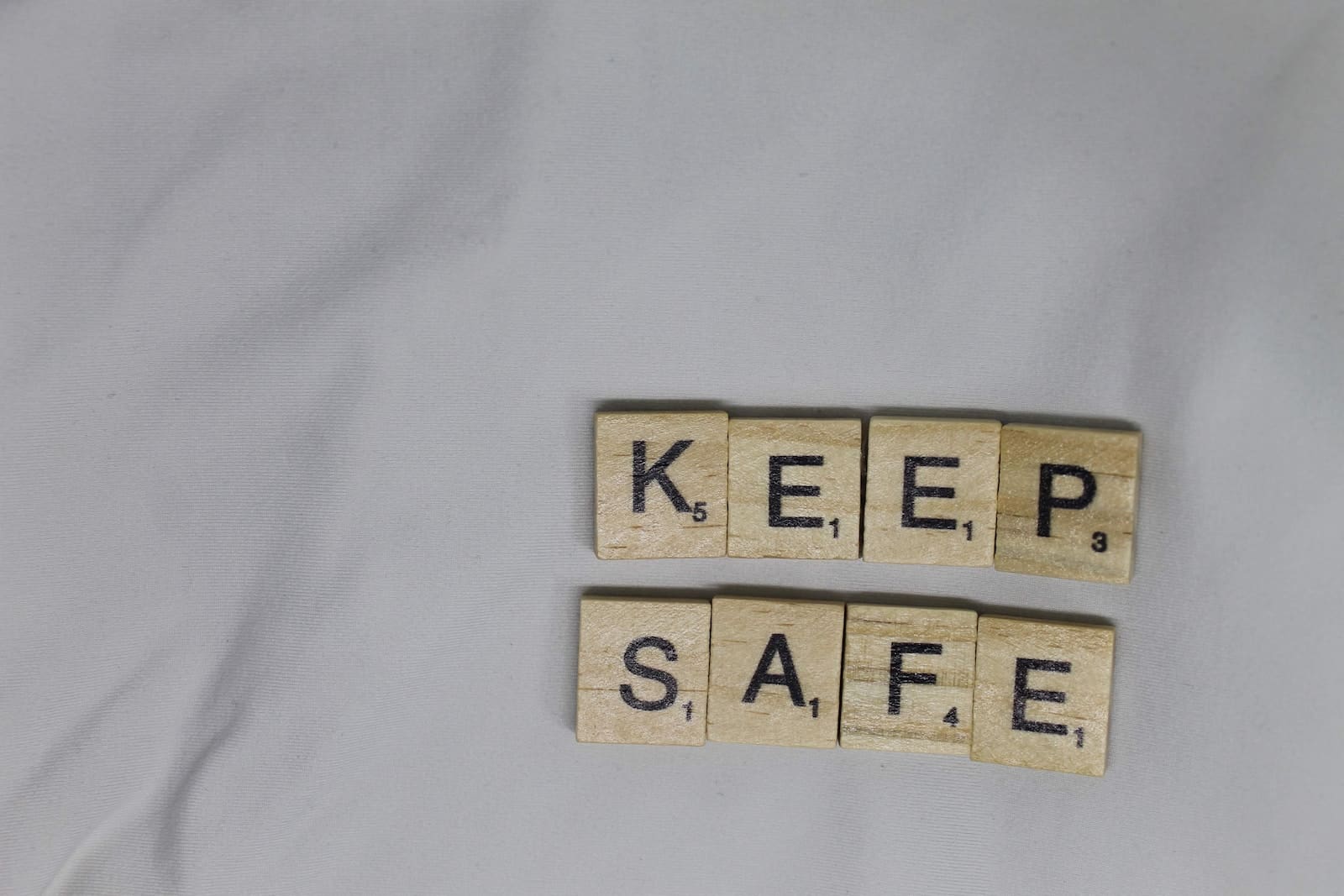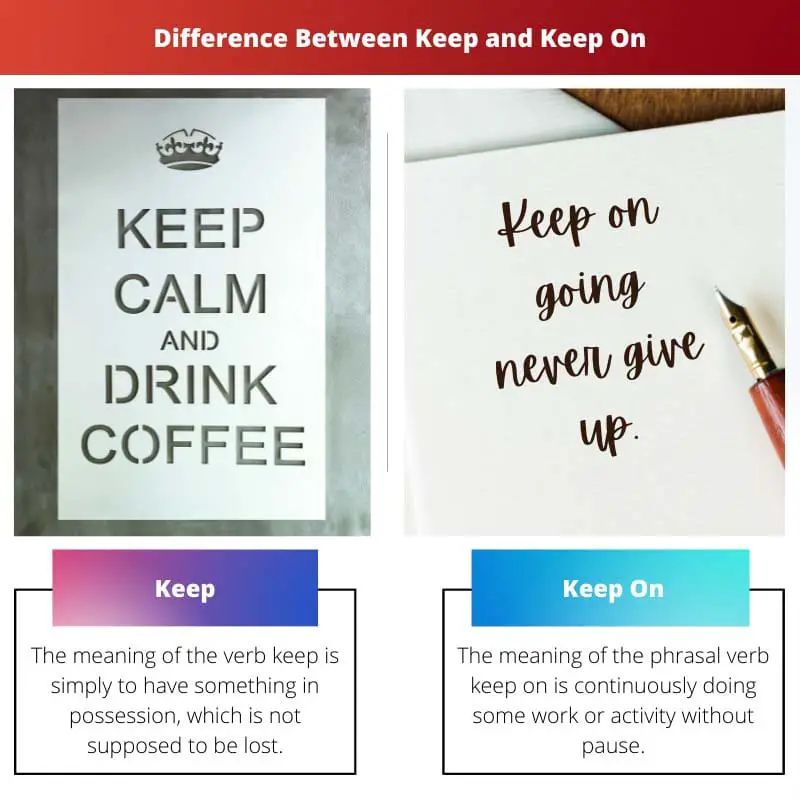Every language has its rules to be narrated in a proper way. A person has to learn all these rules so he can be the master of a particular language.
There are countless words that might look similar to new learners, but they have their separate meanings. Keep and keep on are two such terms.
Key Takeaways
- “Keep” means to continue or retain possession of something, while “keep on” implies persisting or continuing an action.
- “Keep on” is followed by a gerund (verb + -ing), whereas “keep” is followed by a noun or adjective.
- Both phrases convey a sense of continuation, but “keep on” emphasizes the ongoing nature of an action.
Keep vs Keep On
“Keep” means to retain or continue holding something, it can also mean to maintain a particular state or condition. “Keep on,” means to continue doing something without stopping or giving up.

The meaning of keep is to have something or to retain possession of something. It is used as the main verb when forming a sentence to deliver thoughts. Another meaning of keep can be putting someone or something in the same condition.
When an object or person stays in a particular place or state, this situation can be elaborated by the verb ‘keep’.
Keep on is known to be a phrasal verb in English grammar. It means to continue doing some work. The term ‘keep on’ is used informally in place of retaining, sustaining, to continue.
Keep on is made of two different words ‘keep’ and ‘on’ but together the meaning of these words changes completely.
Comparison Table
| Parameters Of Comparison | Keep | Keep On |
|---|---|---|
| Meaning | The meaning of the verb keep is simply to have something in possession, which is not supposed to be lost. | The meaning of the phrasal verb keep on is continuously doing some work or activity without pause. |
| Structure | Keep is a verb, also used as the main verb in affirmative, interrogative, imperative sentences to signify an active action. | Keep on is a phrasal verb, such verbs contain a verb and other elements or simply an adverb. |
| Noun | The verb of English grammar, keep, can be also used as a noun in many particular situations. | The phrasal verb of English grammar, keep on can never be used as a noun in any situation. |
| Transformation | The verb keep can be used as a transitive or intransitive verb because it is the initial form. | The phrasal verb keeps on can’t be used as a transitive and intransitive verb. It is more like an idiom. |
| Synonyms | Some of the synonyms of the verb keep are remain, stay, retain, hold on to, keep possession of, etc. | Some of the synonyms of the phrasal verb keep on are carry on, continue, go on, persist in, etc. |
What is Keep?
Keep is one of the verbs which is provided by the English language to denote an activity or action. It is a very common and frequently used word. The type of this word, according to grammar rules, is a verb.
Depending on the type of content, it can be used as both transitive and intransitive verbs.
The word keep means to have something with attentiveness, in other words, there should not be the intention of losing, giving away, selling, throwing away, or giving back that respective object.
We can use some examples like ‘keep the key’, ‘keep the changes’, ‘keep running’, etc. Other meanings of the word keep exist, such as commemorate, celebrate, or observe something.
These meanings are similar to the previous one. Examples that can be given are to keep celebrating this day, to keep the observation going on, to keep loving people, etc.
The Idea emphasized by Keep is not to neglect something or not to violate something.
The verb ‘keep’ can be used as a noun as well. The verb ‘keep’ can be used in place of nouns such as Jail or prison, parts of abandoned medieval castles or fortresses, to be in charge or custody, maintenance, etc.
In short, it can change its form according to the need of a sentence.

What is Keep On?
Keep on is a phrasal verb made of two words: keep and on. It is much different from a verb. Keep on is commonly used before or with a gerund clause. By gerunds, one can understand when a verb becomes a noun using ‘ing’ in its ending.
For better understanding, some examples can be used such as keep on hoping, keep on loving, keep on walking, keep on jumping, etc.
It denotes an intention of the continuous process of an activity. The phrasal verb keep on indicates that the subject doing an action without planning to stop can be signified. The word ‘on’ after keep is used to emphasize the importance of the activity.
This feature makes keep on usable in idioms. In other words, the continuous process of working at something can be known as keeping on.
The phrasal verb ‘keep on’ can also be used to encourage someone. For example, our team will keep on top, don’t keep on waiting and grab the chance, keep on doing well, may you keep on good terms, etc.
It is also used for things that remain in the same state or condition. So, these explanations are used to describe the widely used phrasal verb ‘keep on’.
Main Differences Between Keep and Keep On
- The antonyms of ‘keep’ are throw away, lose, disobey, etc. While antonyms of keep on are dismissed and stopped, which explains a lot.
- There can be transitive and intransitive forms of the verb keep, while there can not be such forms of the phrasal verb keep on.
- Keep is a verb and always used as a verb, while keep on is a phrasal verb that can be used as an idiom.
- The verb keep means to have something or to possess something, while ‘keep on’ means to carry on a constant term.
- In some conditions, keep becomes a noun. On the other hand, keep on is mostly used as a verb and never a noun.




